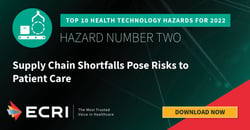 ECRI’s Top 10 Health Technology Hazards for 2022 ranks supply chain shortages among the top three risks facing healthcare organizations. The ranking is for good reason: patient lives may be at risk if essential medical supplies and equipment are unavailable. This risk increases as global supply chain disruption continues to impact healthcare organizations. According to an October 2021 report on healthcare performance, at least 80 percent of hospitals reported supply shortages.
ECRI’s Top 10 Health Technology Hazards for 2022 ranks supply chain shortages among the top three risks facing healthcare organizations. The ranking is for good reason: patient lives may be at risk if essential medical supplies and equipment are unavailable. This risk increases as global supply chain disruption continues to impact healthcare organizations. According to an October 2021 report on healthcare performance, at least 80 percent of hospitals reported supply shortages.
Shortages can stem from the impact of the pandemic, which has sometimes brought manufacturing to a halt. Others are the result of vulnerabilities in traditional supply chain planning, such as keeping limited amounts of products in storage and relying on fast delivery. Weather events and other force majeure incidents also play a role. Together, these create a cascade effect that causes many healthcare organizations to struggle to locate, purchase, and obtain supplies:
- Raw material shortages increase prices and reduce output. For example, shortages of resin impact the availability of plastic and magnesium shortages affect the availability of aluminum – causing issues for manufacturers.
- Suppliers who rely heavily on offshore manufacturers that have been disrupted by the pandemic or global weather events need to find supplies elsewhere.
- Supply chain practices and other pressures reduced organizations’ stockpiles of critical supplies. “Just-in-time’ supply chain models, designed to reduce the need for physical inventory, are upended when products can’t be sourced or delivered on time.
- Logistical challenges, such as ongoing trucking, shipping, and delivery issues brought on by the pandemic, delay delivery of critical supplies.
Given that these circumstances are widespread and ongoing, supply shortages are bound to impact your organization. An ounce of prevention is worth a pound of cure, so what should you take into consideration when planning to meet these challenges? Suggestions outlined in ECRI’s Top 10 Health Technology Hazards 2022 report include:
- Assess your organization’s inventory so you know which supplies may be impacted and build a stockpile of these items.
- Ask for increased transparency from your provider or GPO. Question where supplies are being sourced, whether those geographic regions are being impacted, and if there are alternative suppliers in the event products are unavailable.
- Determine which alternative products can meet your needs. Having insight into functionally-equivalent alternatives, as well as their pricing and availability, helps you more readily navigate shortages.
- Partner with an unbiased organization who can provide perspective on the global marketplace and pinpoint areas of concern. An unfiltered view of the market allows organizations to be proactive, navigate future disruption, and better establish yourself from a negotiation and strategic standpoint.
While supply shortages will continue in the current environment, being prepared to handle them will help keep supplies in stock and ensure patient safety. Download your copy of the Executive Brief to learn more about how to prepare your organization to manage supply shortfalls. ECRI members can access the entire report through their membership page
If shortages are causing issues for your hospital, ECRI’s is here to help. Visit our Resource Center for the latest information to help you navigate supply chain shortfalls, or contact us today for additional information.
